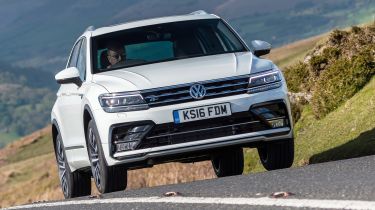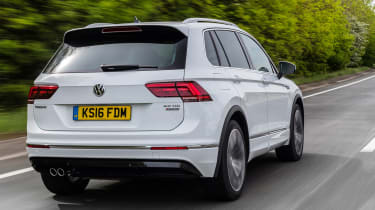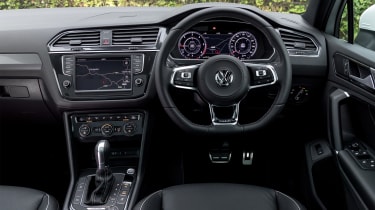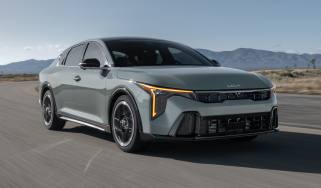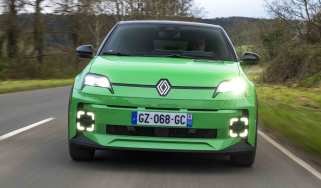VW Tiguan R-Line 2016 review
Flagship Volkswagen Tiguan R-Line adds plenty of appeal, but it comes at a cost

The new Tiguan is a definite improvement on its predecessor, with an increase in practicality, build quality and driver appeal. R-Line models also ramp up desirability, too, but at a cost. This particular Tiguan wears a seriously premium price tag without the adjoining performance and efficiency. A two-wheel drive SE-L spec car is a better all-rounder.
One of the best ways of measuring the current European obsession with SUVs is by looking at sales of the first VW Tiguan. Back in 2011 – when cars like the well-established Nissan Qashqai were popular but not dominant – the Golf-based crossover racked up 8,000 sales in the UK. By 2015 – a full seven years into its lifespan – VW shifted 21,000.
It’s a seriously important car for Volkswagen, then, but that doesn’t mean the brand has rested on its laurels. The long-awaited new Tiguan is fresh from the ground-up: it gets the latest ‘MQB’ platform architecture, is longer, wider and lower and looks notably different in the flesh.
Where the old Tiguan looked like a raised-up Golf that was ashamed to call itself an SUV, the new car wades into battle with a much more muscular and square-jawed design. It’s a stark contrast to the curves and swept-back headlights of the Renault Kadjar. But beware – the kerb appeal of your Tiguan will depend heavily on how it is specced.
More reviews
Car group tests
- Volkswagen Tiguan vs BYD Seal U: can this new arrival beat a firm favourite?
- Volkswagen Tiguan vs Renault Kadjar: is petrol or diesel better in a used family SUV?
- Volkswagen Tiguan vs Hyundai Tucson 2024 twin test: family SUVs fight it out
- Volkswagen Tiguan Allspace vs Kia Sorento: 2022 twin test review
In-depth reviews
Used car tests
• Best SUVs and 4x4s on sale right now
The flagship R-Line you see here benefits from a host of styling upgrades including enormous 20-inch alloys, chunkier air intakes, sporty front and rear bumper designs and piano black trim. Combined with the standard-fit LED headlights it’ll certainly get you noticed. The smaller wheels, halogen headlamps and standard bodywork of S or even SE spec look quite plain by comparison.
R-Line cars also bring a few interior upgrades, but the effect is much more subtle. The black rooflining, aluminium-look dash inserts, unique badging and classier seat trim lift the ambience slightly, but then lesser models are hardly basic inside. The layout will be instantly familiar to anyone stepping out of a Golf or Passat, and trim quality is in line with other models in the range. It’s solid and upmarket throughout, though you may have expected even more considering the Tiguan is now much pricier than a Golf.
One addition that R-Line spec also offers as standard is the slick 12.3inch Active Info Display in place of the regular dials. Essentially the same as the system found in top-flight Passats (and most Audis) it’s a sharp, clear and intuitive way of displaying a variety of different info. Models fitted with 4Motion four-wheel drive can even display info such as wheel departure angles.
Behind all of the gloss and sheen, the Tiguan is also one of the most practical cars in its class. Seats-up, the large, well-shaped 615-litre boot beats even the Honda CR-V for capacity, and once the seats are folded down (easily, via boot-mounted handles) it increases to a substantial 1,655 litres. There’s generous head and legroom for adults, too, while tray tables and a raft of storage for oddments add to the family-friendly feel. All 4Motion Tiguans can tow an impressive 2,500kg, too, while a suite of active safety kit is standard.
On the face of it, then, this Tiguan offers what you’d expect from a top-flight midsize SUV, but on the road it’s a slightly different story. R-Line trim can be ordered on the most powerful engines – including a 237bhp twin-turbo diesel – but the only model available to try at launch was the mid-spec 148bhp oil-burner. As we found when we tested it in manual SE spec, this means performance is decent but not outstanding.
In theory, this car’s seven-speed DSG gearbox should help you make the most of the performance on offer, and its slick, quick shifts do make things smoother. However in Sport mode (and sometimes even in Drive) flooring the throttle just results in it dropping too many cogs and leaving you in the breathless upper limits of its rev band. Efficiency takes a hit on this top-spec, four-wheel drive models too: it emits 149g/km of CO2 and manages 149g/km – figures that are barely better than the old Tiguan.
Handling-wise, the Tiguan delivers most of the precision and agility you’d expect from the MQB platform, with accurate steering and a tied-down feel. R-Line trim’s sports suspension enhances this even further – but at a price. The ride goes from firm but controlled in SE spec to fidgety and quite choppy, as the big wheels loudly crash and thump into large potholes. It’s never uncomfortable, but it doesn’t cosset passengers as well as the premium rivals it’s aiming at. Also, while an off-road course showed the Tiguan’s strong capabilities in the mud, you’re hardly likely to risk damaging those alloys if you buy one with your own money.
The biggest problem with this particular version, however, is the price. Before you’ve even troubled the extensive options list you’re looking at a £35,000 car, which not only puts it well in excess of SUVs like the Nissan Qashqai, but also right in the firing line of the BMW X3 and not far away from the Jaguar F-Pace. It seems VW has priced its top-flight Tiguans like they’re Audis.
